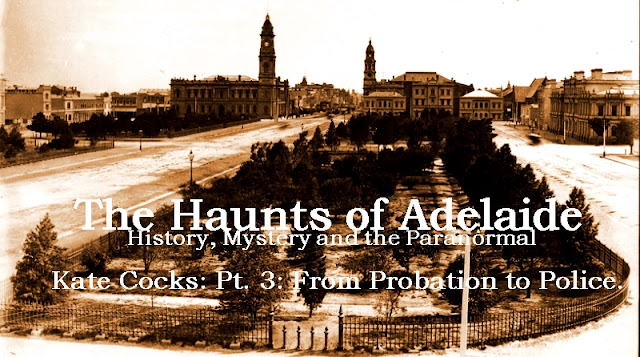Kate Cocks: Pt. 3: From Probation to Police.
The impact of South Australia’s male
population serving in World War One overseas saw a large proportion of the States
females suffering, not only the worry of their male relatives and friends being away overseas,
and the very real possibility of being killed in action, but also the
responsibility of being able to feed their families. With the main wage earner
away, women had to find work, some managed to find jobs supporting the war
effort, but there weren’t enough jobs for every one, consequently, many young
women turned to prostitution to support themselves and their families.
Church and community groups became concerned about the welfare of women in the state, and began to push the State Government toward employing female police officers to help alleviate the social problems they were witnessing.
The Police
commissioner, William Raymond, did not like the concept at all, and out-rightly
dismissed the idea. A.W. Styles, the Chief Secretary, pushed harder, and turned
to Crown Solicitor, Charles Dashwood, who advised there were no legal barriers
to employing women as police officers.
On September
27, 1915 an expression of interest, advertising for female police officers in
South Australia, appeared in The
Advertiser Newspaper.
More than 200 women applied for the
initial positions within the first week!
Despite the
maximum age for women to join the South Australian Police Force at the time
being 29 years old, 40 year old Kate Cocks, was given the position of
Principal Police Matron and offered six assistants. She declined the six assistants, and instead
asked for just one, Annie Ross. (both women were over 29 years old, but the
rule was waived for them to join.)
On the first of December 1915, South Australia had its
first two females police officers, both serving at the same pay rate as men, a
first for the British Empire.
The women
served from their own department, based at Victoria Square, known as “The Women
Police Office”. The women mainly worked in a social welfare capacity, often
they walked the areas known mainly for prostitution: Rosina Street, Light
Square, and especially around Port Adelaide’s wharf's and railway station. Their
first official job was to watch over women who were seen coming and going from
soldier camps around the city.
Cocks said in a newspaper article many years later, about patrolling the wartime camps;
Cocks said in a newspaper article many years later, about patrolling the wartime camps;
“Many
of the girls we had to protect were by no means vicious but were caught up in a
wave of emotionalism through a certain glamor that surrounded heroes in khaki.
All along the river we patrolled and in the vicinity of the Cheer-up Hut, too.”
''Many girls were semi-hysterical over their friends going away, perhaps to be killed. People who judged them harshly did not dig down deeply enough into the cause of their unbalanced state of mind”.
''Many girls were semi-hysterical over their friends going away, perhaps to be killed. People who judged them harshly did not dig down deeply enough into the cause of their unbalanced state of mind”.
Until the mid-1920’s, when Ms. Cocks applied to carry
a small firearm, the women police force were armed only with a baton, police
whistles, badge and ID card, and wore their own clothing. Cocks was proficient
in Ju-jitsu and had taught one young lady who had suffered from an abusive husband, how
to defend herself from him.
Cocks went on
to serve for twenty years in the South Australian Police Force, only retiring
in 1935 to look after her dying mother.
Researched and written by Allen Tiller © 2018
Bibliography on final post


No comments:
Post a Comment